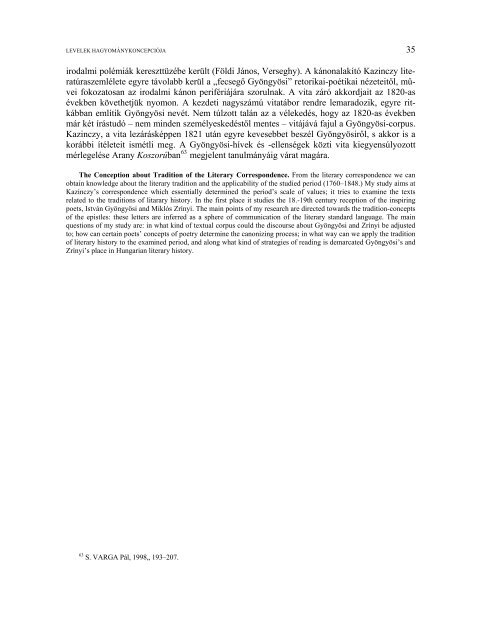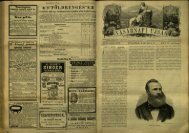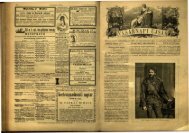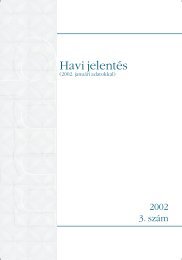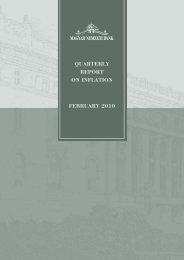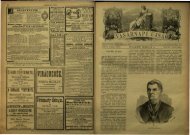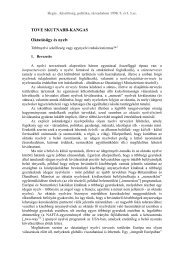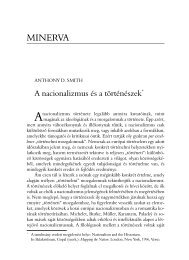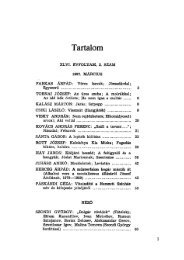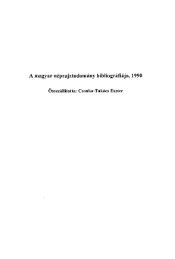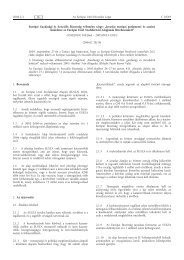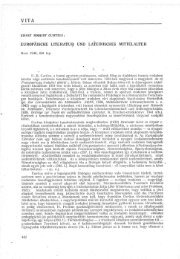- Page 1 and 2: Tüskés Gábor A konferencia-köte
- Page 3 and 4: A KONFERENCIA-KÖTET ELÉ 3 tudnak
- Page 5 and 6: A FELVILÁGOSODÁS HATÁRAI ÉS HAT
- Page 7 and 8: A FELVILÁGOSODÁS HATÁRAI ÉS HAT
- Page 9 and 10: A FELVILÁGOSODÁS HATÁRAI ÉS HAT
- Page 11 and 12: A FELVILÁGOSODÁS HATÁRAI ÉS HAT
- Page 13 and 14: I. NYELV, OLVASÁS, FILOZÓFIA Hege
- Page 15 and 16: ERDÉLYI SZERZŐK, FORDÍTÓK NYELV
- Page 17 and 18: ERDÉLYI SZERZŐK, FORDÍTÓK NYELV
- Page 19 and 20: ERDÉLYI SZERZŐK, FORDÍTÓK NYELV
- Page 21 and 22: ERDÉLYI SZERZŐK, FORDÍTÓK NYELV
- Page 23 and 24: LEVELEK HAGYOMÁNYKONCEPCIÓJA 23 2
- Page 25 and 26: LEVELEK HAGYOMÁNYKONCEPCIÓJA 25 A
- Page 27 and 28: LEVELEK HAGYOMÁNYKONCEPCIÓJA 27 m
- Page 29 and 30: LEVELEK HAGYOMÁNYKONCEPCIÓJA 29 a
- Page 31 and 32: LEVELEK HAGYOMÁNYKONCEPCIÓJA 31 M
- Page 33: LEVELEK HAGYOMÁNYKONCEPCIÓJA 33 r
- Page 37 and 38: A POLIHISZTOR VISELKEDÉSHAGYOMÁNY
- Page 39 and 40: A POLIHISZTOR VISELKEDÉSHAGYOMÁNY
- Page 41 and 42: A POLIHISZTOR VISELKEDÉSHAGYOMÁNY
- Page 43 and 44: A POLIHISZTOR VISELKEDÉSHAGYOMÁNY
- Page 45 and 46: A POLIHISZTOR VISELKEDÉSHAGYOMÁNY
- Page 47 and 48: A POLIHISZTOR VISELKEDÉSHAGYOMÁNY
- Page 49 and 50: POPULÁRFILOZÓFIAI ESZMÉK AZ ERD
- Page 51 and 52: POPULÁRFILOZÓFIAI ESZMÉK AZ ERD
- Page 53 and 54: POPULÁRFILOZÓFIAI ESZMÉK AZ ERD
- Page 55 and 56: POPULÁRFILOZÓFIAI ESZMÉK AZ ERD
- Page 57 and 58: POPULÁRFILOZÓFIAI ESZMÉK AZ ERD
- Page 59 and 60: POPULÁRFILOZÓFIAI ESZMÉK AZ ERD
- Page 61 and 62: Labádi Gergely Az olvasó pásztor
- Page 63 and 64: AZ OLVASÓ PÁSZTOR 63 Hogyan, és
- Page 65 and 66: AZ OLVASÓ PÁSZTOR 65 által” f
- Page 67 and 68: AZ OLVASÓ PÁSZTOR 67 si egyházk
- Page 69 and 70: AZ OLVASÓ PÁSZTOR 69 A tárgyalt
- Page 71 and 72: AZ OLVASÓ PÁSZTOR 71 tett fundame
- Page 73 and 74: AZ OLVASÓ PÁSZTOR 73 azonban alig
- Page 75 and 76: AZ OLVASÓ PÁSZTOR 75 aztán egy j
- Page 77 and 78: Pavercsik Ilona Az erdélyi könyvk
- Page 79 and 80: AZ ERDÉLYI KÖNYVKERESKEDELEM MAGY
- Page 81 and 82: AZ ERDÉLYI KÖNYVKERESKEDELEM MAGY
- Page 83 and 84: AZ ERDÉLYI KÖNYVKERESKEDELEM MAGY
- Page 85 and 86:
AZ ERDÉLYI KÖNYVKERESKEDELEM MAGY
- Page 87 and 88:
Granasztói Olga XVIII. századi f
- Page 89 and 90:
XVIII. SZÁZADI FŐÚRI KÖNYVKULT
- Page 91 and 92:
XVIII. SZÁZADI FŐÚRI KÖNYVKULT
- Page 93 and 94:
XVIII. SZÁZADI FŐÚRI KÖNYVKULT
- Page 95 and 96:
FALUDI FERENC MUNKÁINAK ERDÉLYI O
- Page 97 and 98:
FALUDI FERENC MUNKÁINAK ERDÉLYI O
- Page 99 and 100:
FALUDI FERENC MUNKÁINAK ERDÉLYI O
- Page 101 and 102:
FALUDI FERENC MUNKÁINAK ERDÉLYI O
- Page 103 and 104:
FALUDI FERENC MUNKÁINAK ERDÉLYI O
- Page 105 and 106:
FALUDI FERENC MUNKÁINAK ERDÉLYI O
- Page 107 and 108:
FALUDI FERENC MUNKÁINAK ERDÉLYI O
- Page 109 and 110:
FALUDI FERENC MUNKÁINAK ERDÉLYI O
- Page 111 and 112:
FALUDI FERENC MUNKÁINAK ERDÉLYI O
- Page 113 and 114:
Bartha Katalin Ágnes A drámaolvas
- Page 115 and 116:
A DRÁMAOLVASÁS NYOMÁBAN A XVIII.
- Page 117 and 118:
A DRÁMAOLVASÁS NYOMÁBAN A XVIII.
- Page 119 and 120:
A DRÁMAOLVASÁS NYOMÁBAN A XVIII.
- Page 121 and 122:
A DRÁMAOLVASÁS NYOMÁBAN A XVIII.
- Page 123 and 124:
A DRÁMAOLVASÁS NYOMÁBAN A XVIII.
- Page 125 and 126:
A DRÁMAOLVASÁS NYOMÁBAN A XVIII.
- Page 127 and 128:
A DRÁMAOLVASÁS NYOMÁBAN A XVIII.
- Page 129 and 130:
A DRÁMAOLVASÁS NYOMÁBAN A XVIII.
- Page 131 and 132:
A DRÁMAOLVASÁS NYOMÁBAN A XVIII.
- Page 133 and 134:
II. ISKOLA, ALKOTÁSMÓDOK, SZÖVEG
- Page 135 and 136:
TÁJÉLMÉNY EGYIK DEÁKOSUNKNÁL 1
- Page 137 and 138:
TÁJÉLMÉNY EGYIK DEÁKOSUNKNÁL 1
- Page 139 and 140:
TÁJÉLMÉNY EGYIK DEÁKOSUNKNÁL 1
- Page 141 and 142:
TÁJÉLMÉNY EGYIK DEÁKOSUNKNÁL 1
- Page 143 and 144:
TÁJÉLMÉNY EGYIK DEÁKOSUNKNÁL 1
- Page 145 and 146:
Hubert Ildikó Tájélmény egyik d
- Page 147 and 148:
TÁJÉLMÉNY EGYIK DEÁKOSUNKNÁL 1
- Page 149 and 150:
TÁJÉLMÉNY EGYIK DEÁKOSUNKNÁL 1
- Page 151 and 152:
TÁJÉLMÉNY EGYIK DEÁKOSUNKNÁL 1
- Page 153 and 154:
EGY KONZERVATÍV A KÖZTÁRSASÁGIA
- Page 155 and 156:
EGY KONZERVATÍV A KÖZTÁRSASÁGIA
- Page 157 and 158:
Csörsz Rumen István Közköltész
- Page 159 and 160:
KÖZKÖLTÉSZET ERDÉLYBEN A XVIII.
- Page 161 and 162:
KÖZKÖLTÉSZET ERDÉLYBEN A XVIII.
- Page 163 and 164:
KÖZKÖLTÉSZET ERDÉLYBEN A XVIII.
- Page 165 and 166:
KÖZKÖLTÉSZET ERDÉLYBEN A XVIII.
- Page 167 and 168:
Egyed Emese Versjelhagyás, erdély
- Page 169 and 170:
VERSJELHAGYÁS, ERDÉLYI UTÓRENESZ
- Page 171 and 172:
VERSJELHAGYÁS, ERDÉLYI UTÓRENESZ
- Page 173 and 174:
VERSJELHAGYÁS, ERDÉLYI UTÓRENESZ
- Page 175 and 176:
VERSJELHAGYÁS, ERDÉLYI UTÓRENESZ
- Page 177 and 178:
VERSJELHAGYÁS, ERDÉLYI UTÓRENESZ
- Page 179 and 180:
VERSJELHAGYÁS, ERDÉLYI UTÓRENESZ
- Page 181 and 182:
ORCZY LŐRINC FORDÍTÁSTÖREDÉKE
- Page 183 and 184:
ORCZY LŐRINC FORDÍTÁSTÖREDÉKE
- Page 185 and 186:
ORCZY LŐRINC FORDÍTÁSTÖREDÉKE
- Page 187 and 188:
Dóczy Örs Buccow-ellenes röpirat
- Page 189 and 190:
BUCCOW-ELLENES RÖPIRATOK TELEKI S
- Page 191 and 192:
BUCCOW-ELLENES RÖPIRATOK TELEKI S
- Page 193 and 194:
BUCCOW-ELLENES RÖPIRATOK TELEKI S
- Page 195 and 196:
BUCCOW-ELLENES RÖPIRATOK TELEKI S
- Page 197 and 198:
A HASBURG-URALOM ERDÉLYI KÖVETKEZ
- Page 199 and 200:
A HASBURG-URALOM ERDÉLYI KÖVETKEZ
- Page 201 and 202:
A HASBURG-URALOM ERDÉLYI KÖVETKEZ
- Page 203 and 204:
A HASBURG-URALOM ERDÉLYI KÖVETKEZ
- Page 205 and 206:
A HASBURG-URALOM ERDÉLYI KÖVETKEZ
- Page 207 and 208:
A HASBURG-URALOM ERDÉLYI KÖVETKEZ
- Page 209 and 210:
A HASBURG-URALOM ERDÉLYI KÖVETKEZ
- Page 211 and 212:
„HAH, MINŐ REZZENŐ PILLANAT, EL
- Page 213 and 214:
„HAH, MINŐ REZZENŐ PILLANAT, EL
- Page 215 and 216:
„HAH, MINŐ REZZENŐ PILLANAT, EL
- Page 217 and 218:
KIKET ISMERHETETT GYÖNGYÖSSI JÁN
- Page 219 and 220:
KIKET ISMERHETETT GYÖNGYÖSSI JÁN
- Page 221 and 222:
KIKET ISMERHETETT GYÖNGYÖSSI JÁN
- Page 223 and 224:
KIKET ISMERHETETT GYÖNGYÖSSI JÁN
- Page 225 and 226:
KIKET ISMERHETETT GYÖNGYÖSSI JÁN
- Page 227 and 228:
KIKET ISMERHETETT GYÖNGYÖSSI JÁN
- Page 229 and 230:
Bodó Márta „A’ Kegyes Oskolá
- Page 231 and 232:
„A’ KEGYES OSKOLÁK RENDJE’ M
- Page 233 and 234:
„A’ KEGYES OSKOLÁK RENDJE’ M
- Page 235 and 236:
„A’ KEGYES OSKOLÁK RENDJE’ M
- Page 237 and 238:
Vulkán Vera Tünde Egy Mártonffy-
- Page 239 and 240:
EGY MÁRTONFFY-PORTRÉ CSEREY FARKA
- Page 241 and 242:
EGY MÁRTONFFY-PORTRÉ CSEREY FARKA
- Page 243 and 244:
EGY MÁRTONFFY-PORTRÉ CSEREY FARKA
- Page 245 and 246:
EGY MÁRTONFFY-PORTRÉ CSEREY FARKA
- Page 247 and 248:
II. JÓZSEFHEZ INTÉZETT BEADVÁNYO
- Page 249 and 250:
II. JÓZSEFHEZ INTÉZETT BEADVÁNYO
- Page 251 and 252:
II. JÓZSEFHEZ INTÉZETT BEADVÁNYO
- Page 253 and 254:
II. JÓZSEFHEZ INTÉZETT BEADVÁNYO
- Page 255 and 256:
„AZT A’ BOJTORJÁN, IZGÁGA SOP
- Page 257 and 258:
„AZT A’ BOJTORJÁN, IZGÁGA SOP
- Page 259 and 260:
„AZT A’ BOJTORJÁN, IZGÁGA SOP
- Page 261 and 262:
„AZT A’ BOJTORJÁN, IZGÁGA SOP
- Page 263 and 264:
„AZT A’ BOJTORJÁN, IZGÁGA SOP
- Page 265 and 266:
„AZT A’ BOJTORJÁN, IZGÁGA SOP
- Page 267 and 268:
ARANKA GYÖRGY LEVELEZÉSE 267 poli
- Page 269 and 270:
ARANKA GYÖRGY LEVELEZÉSE 269 Stat
- Page 271 and 272:
ARANKA GYÖRGY LEVELEZÉSE 271 böz
- Page 273 and 274:
ARANKA GYÖRGY LEVELEZÉSE 273 rom
- Page 275 and 276:
ARANKA GYÖRGY LEVELEZÉSE 275 tika
- Page 277 and 278:
Király Emőke Aranka György level
- Page 279 and 280:
ARANKA GYÖRGY LEVELEZÉSE 279 alat
- Page 281 and 282:
ARANKA GYÖRGY LEVELEZÉSE 281 Teut
- Page 283 and 284:
ARANKA GYÖRGY LEVELEZÉSE 283 2.
- Page 285 and 286:
ARANKA GYÖRGY LEVELEZÉSE 285 6.
- Page 287 and 288:
ARANKA GYÖRGY LEVELEZÉSE 287 9.
- Page 289 and 290:
ARANKA GYÖRGY LEVELEZÉSE 289 komp
- Page 291 and 292:
ÖSSZESÍTETT BIBLIOGRÁFIA 291 BAK
- Page 293 and 294:
ÖSSZESÍTETT BIBLIOGRÁFIA 293 BOD
- Page 295 and 296:
ÖSSZESÍTETT BIBLIOGRÁFIA 295 DUK
- Page 297 and 298:
ÖSSZESÍTETT BIBLIOGRÁFIA 297 FEL
- Page 299 and 300:
ÖSSZESÍTETT BIBLIOGRÁFIA 299 199
- Page 301 and 302:
ÖSSZESÍTETT BIBLIOGRÁFIA 301 JEN
- Page 303 and 304:
ÖSSZESÍTETT BIBLIOGRÁFIA 303 KÓ
- Page 305 and 306:
ÖSSZESÍTETT BIBLIOGRÁFIA 305 178
- Page 307 and 308:
ÖSSZESÍTETT BIBLIOGRÁFIA 307 NEM
- Page 309 and 310:
ÖSSZESÍTETT BIBLIOGRÁFIA 309 RÓ
- Page 311 and 312:
ÖSSZESÍTETT BIBLIOGRÁFIA 311 SZA
- Page 313 and 314:
ÖSSZESÍTETT BIBLIOGRÁFIA 313 TES
- Page 315 and 316:
ÖSSZESÍTETT BIBLIOGRÁFIA 315 WAL
- Page 317 and 318:
Kiállításkatalógus A felvilágo
- Page 319 and 320:
KIÁLLÍTÁSKATALÓGUS 319 14. Volt
- Page 321 and 322:
KIÁLLÍTÁSKATALÓGUS 321 28. Szat
- Page 323 and 324:
KIÁLLÍTÁSKATALÓGUS 323 Jelzete:
- Page 325 and 326:
KIÁLLÍTÁSKATALÓGUS 325 Voltaire
- Page 327 and 328:
KIÁLLÍTÁSKATALÓGUS 327 Corneill
- Page 329 and 330:
Contents Gábor Tüskés: Preface .
- Page 331 and 332:
Tartalom Tüskés Gábor: A konfere


